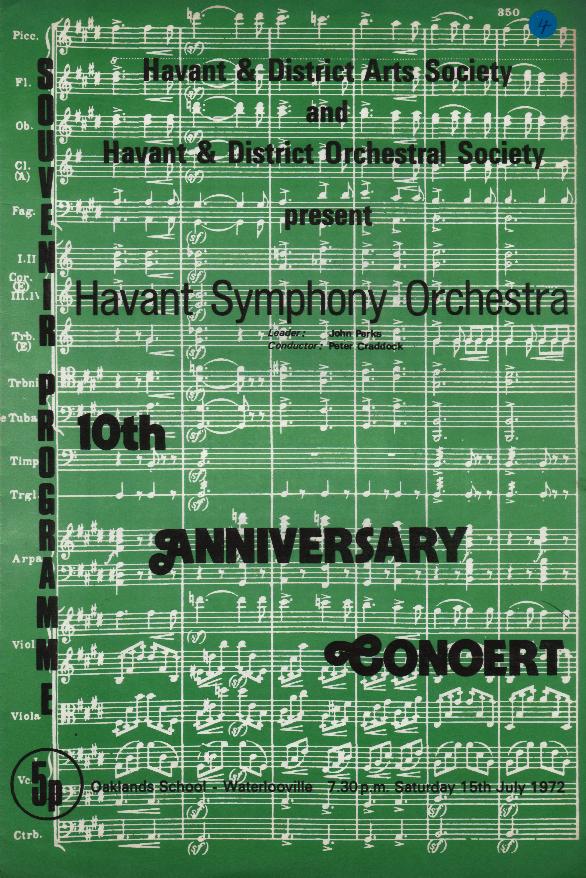CONCERTO DA CAMERA
1979
Oboe and string orchestra.
Commissioned by the Havant Chamber Orchestra with funds from the Southern Arts Association and the Arts Council of Great Britain.
First performed 16 June 1979 with Geoffrey Bridge (oboe) and the Orchestra, conducted by Peter Craddock.
Orchestration 1021/2000/str
Broadcast BBC Radio 3, 12 September 1984
Sarah Francis, BBC Concert Orchestra, Ashley Lawrence
Michael Hurd wrote: " When the Havant Chamber Orchestra decided to commission a work from me I was delighted not only to celebrate its skills and those of its conductor Peter Craddock, but also those of Geoffrey Bridge, whose playing I have always admired.
There is little to be said about the music's structure, which follows traditional classical patterns, or its style, which is also traditional and unproblematic.
But it is perhaps worth pointing out that the principal themes in all three movements spring from the same two basic cells; the first derived from the notes C, B and E and the second from an undulating figure heard in the first movement as B, A, B. In the first movement these occur in an E minor context. This becomes A minor in the second movement and E major in the third.
Finally the concerto is by way of being a tribute to the genius of one of my favourite composers, Francis Poulenc, and like his work seeks simply to 'give delight and hurt not' in a world where obfuscation and gloom are too often the order of the day."
Recording details here.
DANCE DIVERSIONS
1972

Programme from the first performance (from the personal archive of Peter Craddock)
Orchestral. 15'.
Commissioned to celebrate the tenth anniversary of the Havant Symphony Orchestra, conductor Peter Craddock.
First performance Oaklands School, Waterlooville, 15 July 1972.
2 flutes 2 oboes 2 clarinets in B flat 2 bassoons
2 horns in F 2 trumpets in B flat tenor trombone bass trombone
timpani (3) percussion (1) side drum, cymbal, triangle, wood block
strings
" The five contrasted movements that make up this suite are dances only in the balletic sense: you could dance them but not necessarily to any existing steps. Nevertheless, at least four movements make reference to common dance rhythms.
The first, for example, combines something of the hornpipe with a barn dance. The second is a kind of slow waltz and so too is the fourth movement - though here perhaps the flavour of English folksong is more evident.
The last movement is quite definitely a Scottish reel. The third movement is anybody's guess - I simply felt the need for something with a stroing, jagged rhythm to offset the two andante movements.
No analysis is needed as a guide to the music, for there are no problems - just one damned tune after another, suitably organised. Peter Craddock asked for something cheerful, colourful and tuneful and this is I hope what he he has got.
My diary tells me that I began to sketch the music at the end of February [1972] but that I did most of the work in a sudden fit of desperation (March 14th-24th).This is always the way it goes - the real work only begins when every available option has been exhausted."
Michael Hurd's programme note from the premiere.
" Apart from the last, a kind of highland reel, the movements follow no particular dance metre, but explore instead contrasts of mood and rhythm that, in the balletic sense, might well be danced.
Structurally simple, they rely unashamedly on melody, though with the occasional harmonic and rhythmic twist to side-step the obvious."
Philip Lane (CD sleeve notes)
Recording details here.
HARLEQUIN SUITE
1971 & 1983
Brass quintet. 7'. Trumpet I Bb, trumpet II Bb, horn F, tenor trombone, tuba.
1: Fanfare
2: Dance
3: Popular Song
4: Ceremony
5: Finale
Commissioned by Watney Mann for the Farnham Festival. First performance by Robert Haining School 11 May 1971. Revised version first performed by John Antill Senior Band, Robert Blackwood Hall, Monash University, Melbourne on 18 June 1983.
OVERTURE TO AN UNWRITTEN COMEDY
1975
Orchestral. 7'.
Commissioned by the Montgomeryshire Youth Orchestra. First performance 31 October 1970.
The title is a nod to one of the composer's favourites, Hubert Parry, after the latter's Overture to an Unwritten Tragedy.
Orchestration 2222/2211/timp perc/strings
Broadcast BBC Radio 3, 23 February 1984
BBC Concert Orchestra, Ashley Lawrence
" This short, light-hearted overture is one of a handful of works I've been inclined to tinker with over a number of years. Its structure is classical and entirely orthodox and involves two themes: one sprightly and whimsical, the other more romantic and lyrical.
Both are built on intervals of the fourth and are therefore closely related. The central section is a grotesque march, after which the main themes return in more or less their original form.
There is no hidden 'programme' behind the music - the comedy is as yet unwritten. "
Composer's programme note, 11 November 1989, for Combined Havant Orchestras concert, Fareham
Recording details here.
PLAINE AND FANCIE
1993
Prelude and fugue for wind band. 4'.
Commissioned by BASBWE Conference, Manchester.
First performance 17 September 1993 by Stewarton Academy Band conducted by Nigel Durno.
SINFONIA CONCERTANTE
1968/1973
Violin and string orchestra. 10'.
Written for and first performed by the Kathleen Merritt Orchestra in 1968. An ms version exists with the title Concertino Pastorale and dated 1973.
This work has been recorded, details and reviews here.